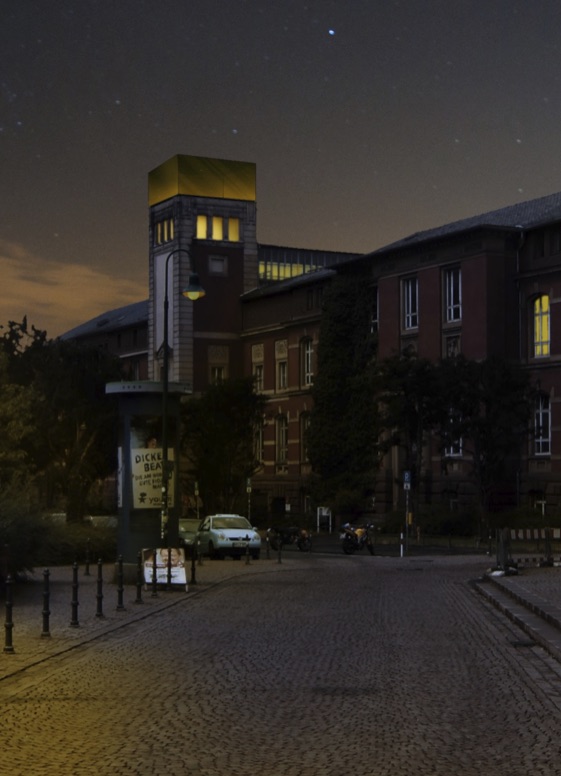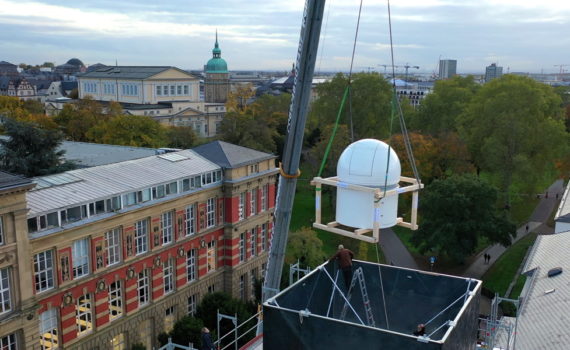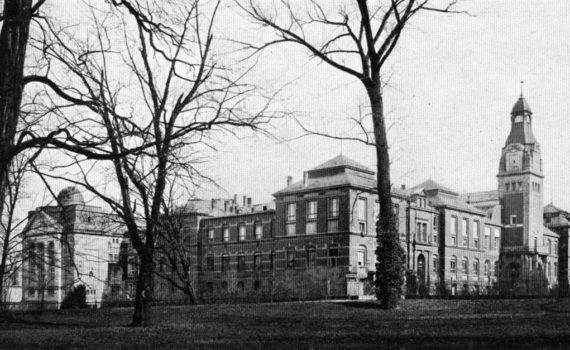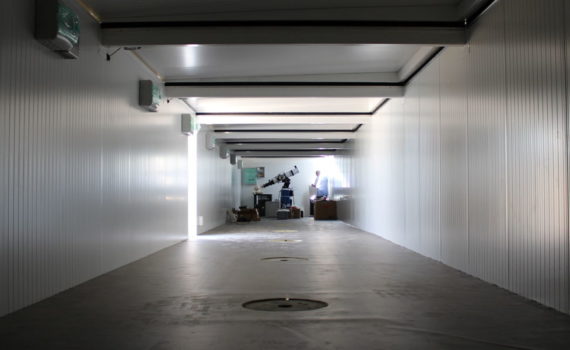
The TURM Observatory is located on the downtown campus of TU Darmstadt on top of the so-called “Uhrturm” and was established in 2020.
With this observatory we provide an environment for students to get individual hands-on experience with astronomical observations, e.g., through advanced lab courses, practical demonstrations accompanying lectures, and voluntary student activities. Over the past years the department has developed a strong research program in theoretical and nuclear astrophysics. However, we did not have research or teaching activities in observational astrophysics or astronomy – a topic which is very attractive for many physics students as well as the general public. We are trying to fill this gap with the TURM Observatory.
The special spot on top of the Uhrturm obviously has pros and cons. The central location is ideal for student, teaching, and outreach activities. However, an observatory in the city center will always suffer from severe light pollution, which limits the range of astronomical objects that can be observed in a meaningful way. Moreover, access to the observatory is difficult, particularly for larger groups of people.
Taking all this into account, we decided to go for a fully remote-controlled observatory that focuses on the observation of the sun and selected night-time objects with modern observational techniques and instruments. All observations happen “electronically” using specialized cameras that are fully computer controlled, as are all other components of the setup. The observer can be anywhere, e.g., in a lecture hall, and operate the complete facility live and interactively, e.g., during a lecture, from a simple laptop computer. Since remote operation is key for this observatory, we call it “TU Darmstadt ReMote Observatory” or “TURM Observatory” for short.
The dome on top of the Uhrturm houses a versatile setup with several telescopes riding on the same mount, an 10micron GM 2000 HPSII equatorial mount. This mount accurately compensates the earth rotation with high accuracy and allows us to point the specific objects in the sky with high precision. […]
The design, construction, and installation of the TURM Observatory on top of the historic Uhrturm was an exciting adventure in itself. Because of the limited space on the platform on top of the Uhrturm we went for the smallest possible dome, a fully automated ScopeDome 2m model. The dome was […]
The historic photograph above shows the view from the Herrengarten towards the buildings of the physics and electrical engineering as well as chemistry institutes of the Technische Hochschule (TH) Darmstadt. The main part of this complex was completed in 1896 based on the design of architect Erwin Marx. The complex […]
TURMX Observatory
During the design and preparation of the TURM Observatory we had a unique opportunity to establish a second telescope setup at a remote location with ideal conditions for night-time observation, i.e., dark skies with minimal light pollution and many clear nights every year. This location is the E-EyE Astronomical Complex in the Extremadura region in Spain.
E-EyE hosts a significant number of professional and amateur telescope systems and provides the complete infrastructure. We have established a robotic telescope system there, which is optimized for imaging of faint objects, such as supernova remnants, star-forming regions, or distant galaxies – and for photometric measurements of variable stars and transiting exoplanets. We call this second observatory “TU Darmstadt ReMote Observatory at E-EyE EXtremadura” or “TURMX Observatory” for short.
The TURMX Observatory at the E-EyE Astronomical Complex near Fregenal de la Sierra in the Extremadura region in Spain ist fully remote operated. Although the are E-EyE technicians on site, in case of technical problems, the goal is to run the setup over an extended period of time without touching […]
We have installed the TURMX setup in August 2019, right after the construction of the new observatory module “Apollo VII” at E-EyE was completed. As shown in the image above, we were the first team to move into the new module. The team at E-EyE had done a great job […]
Support & Funding
This project grew from the active support of individuals who invested their ideas and time to advance the project in many different ways. We would like to thank
- the team of the Mechanical Workshop at the Institut für Angewandte Physik for fabricating important custom-design parts for the telescopes and for lots of technical advice and hands-on help, especially to Arno Weick and Tim Wüst.
- the TURMX installation team that took the long trip to the Extremadura by car to transport and setup the equipment: Thomas Hüther, Marco Knöll, Laura Mertes, Julius Müller, Tobias Wolfgruber, and Ruth Laeri !
- the team at E-EyE for the professional support and a great experience!
- the team of the Dekanat Physik for help with all the administrative things.
Financial support for the project was provided by several organizations and programs. Of course, without this funding, nothing would have happened.
- We thank the Dr. Ing. Wilhelm und Maria Kirmser Stiftung for providing the initial funding for this project as well as the funding for a significant part of the TURMX instrumentation.
- The TURM observatory was supported through the HSP2020 Program at the TU Darmstadt as well as the QSL Program at the Department of Physics.
Many thanks to all,
Franco Laeri & Robert Roth






